
Gymnopilus luteofolius, known as the yellow-gilled gymnopilus, is a large and widely distributed mushroom that grows in dense clusters on dead hardwoods and conifers. It grows in late July to November in the east and in the winter on the west coast of North America. It has a rusty orange spore print and a bitter taste.
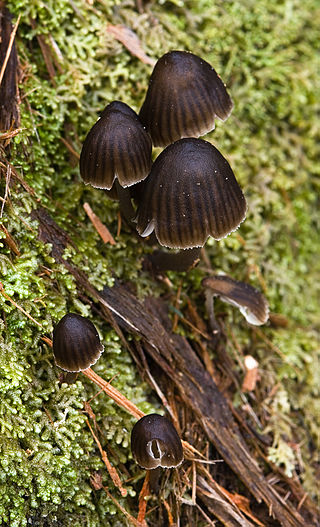
Mycena nargan, commonly known as the Nargan's bonnet, is a species of fungus in the family Mycenaceae, and the sole member of the section Nargan in the genus Mycena. Reported as a new species in 1995, it is known predominantly from Southern Australia. The saprobic fungus produces mushrooms that grow on well-decayed wood, often on the underside of wood lying in litter. The dark chestnut-coloured caps are covered with white, easily removed scales, and reach diameters of up to 2 cm (0.8 in) wide. The pale, slender stems are up to 5 cm (2.0 in) long and have white scales at the base. On the underside of the cap, the cream-coloured gills are widely spaced and bluntly attached to the stem. The edibility of the mushroom is unknown.

Lepiota clypeolaria, commonly known as the shield dapperling or the shaggy-stalked Lepiota, is a common mushroom in the genus Lepiota. It is widely distributed in northern temperate zones, where it grows in deciduous and coniferous forest. Fruit bodies have a brownish cap, a shaggy stipe with a collapsed, sheathing ring or ring zone, and spindle-shaped spores.

Mycena clariviolacea is a mushroom in the family Mycenaceae. First reported as a new species in 2007, it is known only from Kanagawa, Japan, where it fruits on dead fallen twigs in forests dominated by oak and chinquapin trees. Distinctive features of this species are found in its medium-sized, dark violet fruit bodies, with caps up to 25 mm (0.98 in) in diameter and slender stems that are about 30 to 40 mm long. Microscopic characteristics include the amyloid spores, the club-shaped cheilocystidia that are covered with one or more, knob-like, apical protuberances, the absence of pleurocystidia, and the cylindrical, diverticulate caulocystidia.

Mycena fuscoaurantiaca is a species of mushroom in the family Mycenaceae. First reported as a new species in 2007, the diminutive mushroom is only found in Kanagawa, Japan, where it grows on dead fallen twigs in lowland forests dominated by hornbeam (Carpinus) and Chinese evergreen oak trees. The mushroom has a brownish-orange conical cap that has grooves extending to the center, and reaches up to 11 mm (0.43 in) in diameter. Its slender stem is colored similarly to the cap, and long—up to 60 mm (2.4 in) tall. Microscopic characteristics include the weakly amyloid spores, the smooth, swollen cheilocystidia and pleurocystidia with long rounded tips, the diverticulate hyphae of the cap cuticle, and the absence of clamp connections.

Mycena lanuginosa is a species of mushroom in the family Mycenaceae. First collected in 2000 and reported as a new species in 2007, it is known only from lowland oak-dominated forests in central Honshu in Japan. The small mushroom is characterized by its grooved, grayish-brown to violet-brown cap up to 11 mm (0.43 in) in diameter, and the slender grayish-brown to reddish-brown stem covered with minute, fine, soft hairs. The mushroom produces amyloid spores. Microscopic distinguishing features include the smooth, spindle-shaped cheilocystidia and pleurocystidia and the diverticulate elements in the outer layer of the cap and the stem.

Mycena multiplicata is a species of mushroom in the family Mycenaceae. First described as a new species in 2007, the mushroom is known only from Kanagawa, Japan, where it grows on dead fallen twigs in lowland forests dominated by oak. The mushroom has a whitish cap that reaches up to 13 mm (0.51 in) in diameter atop a slender stem 15 to 20 mm long by 1 to 1.3 mm thick. On the underside of the cap are whitish, distantly spaced gills that are narrowly attached to the stem. Microscopic characteristics of the mushroom include the amyloid spores, the pear-shaped to broadly club-shaped cheilocystidia covered with a few to numerous, unevenly spaced, cylindrical protuberances, the lack of pleurocystidia, and the diverticulate hyphae in the outer layer of the cap and stem. The edibility of the mushroom is unknown.

Mycena mustea is a species of mushroom in the family Mycenaceae. First described as a new species in 2007, the fungus is known only from Kanagawa, Japan, where it grows on dead fallen twigs in lowland forests. The mushroom's dull violet to grayish-violet cap, initially covered with a fine whitish powder, becomes smooth as it matures, and eventually reaches a diameter of up to 10 mm (0.39 in). The stem is slender, up to 90 mm (3.5 in) long, and is covered with stiff white hairs at the base. Underneath the cap are distantly spaced pale brownish gills that are narrowly attached to the stem. Microscopic characteristics of the mushroom include the weakly amyloid spores, the club-shaped cheilocystidia featuring one or more short knob-like protuberances, the absence of pleurocystidia, the diverticulate cap cuticle hyphae, and the absence of clamp connections.
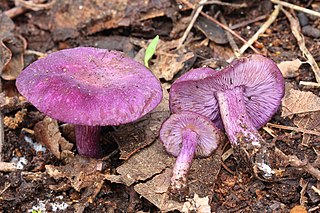
Tricholosporum tropicale is a species of fungus in the family Tricholomataceae. It is found in Mexico.
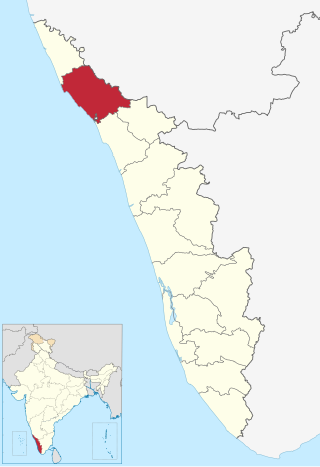
Lepiota babruka is a gilled mushroom of the genus Lepiota in the order Agaricales. Known only from Kerala State, India, it was described as new to science in 2009.

Lepiota babruzalka is an agaric mushroom of the genus Lepiota in the order Agaricales. Described as new to science in 2009, it is found in Kerala State, India, where it grows on the ground in litterfall around bamboo stems. Fruit bodies have caps that measure up to 1.3 cm (0.5 in) in diameter, and are covered with reddish-brown scales. The cap is supported by a long and slender stem up to 4.5 cm (1.8 in) long and 1.5 millimetres (0.1 in) thick. One of the distinguishing microscopic features of the species is the variably shaped cystidia found on the edges of the gills.
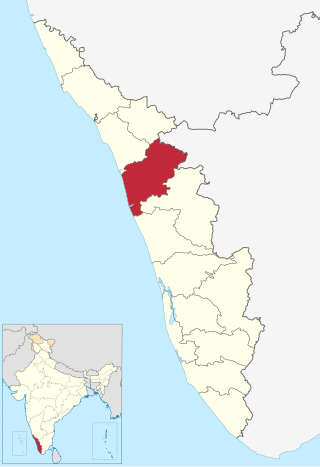
Lepiota harithaka is an agaric mushroom of the genus Lepiota in the order Agaricales. It was described as new to science in 2009. Found in Kerala State, India, fruit bodies of the fungus grow on the ground among bamboo roots.

Lepiota nirupama is a species of agaric fungus of the genus Lepiota in the order Agaricales. Known only from Kerala State in India, it was described as new to science in 2009.

Lepiota shveta is an agaric fungus of the genus Lepiota in the order Agaricales. Described as new to science in 2009, it is found in Kerala State, India.
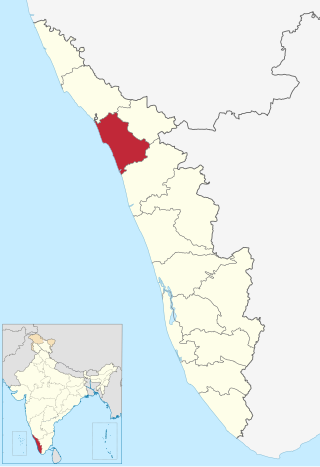
Lepiota zalkavritha is an agaric fungus of the genus Lepiota, order Agaricales. Described as new to science in 2009, it is found in Kerala State, India.

Lepiota ananya is a gilled mushroom of the genus Lepiota in the order Agaricales. Known only to come from Kerala State, India, it was described as new to science in 2009.

Lepiota castaneidisca is a species of agaric fungus in the family Agaricaceae. Formally described in 1912, it was for a long time considered the same species as the similar Lepiota cristata until molecular analysis reported in 2001 demonstrated that it was genetically distinct. It is most common in coastal and northern California, and has also been recorded in Mexico. A saprobic species, it is usually found under redwood and Monterey cypress. Its fruit bodies (mushrooms) have white caps with an orange-red to orange-brown center that measure up to 3.2 cm (1.3 in) wide. The cream-colored to light pink stems are up to 6.5 cm (2.6 in) long by 0.2–0.6 cm (0.1–0.2 in) thick, and have a ring. L. castaneidisca can be distinguished from other similar Lepiota species by differences in habitat, macroscopic, or microscopic characteristics.

Lepiota cristata, commonly known as the stinking dapperling, brown-eyed parasol, or the stinking parasol, is an agaric and possibly poisonous mushroom in the family Agaricaceae. A common and widespread species—one of the most widespread fungi in the genus Lepiota—it has been reported from Europe, northern Asia, North America, and New Zealand. It fruits on the ground in disturbed areas, such as lawns, path and road edges, parks, and gardens. The species produces fruit bodies characterized by the flat, reddish-brown concentric scales on the caps, and an unpleasant odour resembling burnt rubber. Similar Lepiota species can sometimes be distinguished from L. cristata by differences in cap colour, stipe structure, or odour, although some species can only be reliably distinguished through the use of microscopy.
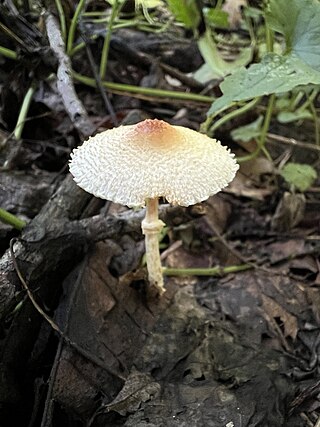
Lepiota maculans is a rare species of agaric fungus in the family Agaricaceae. It was originally collected in Missouri, and then 105 years later in eastern Tennessee. It is the only member of Lepiota known to have a pink spore print instead of the usual white or cream color. The fruit bodies have caps up to 4 cm (1.6 in) in diameter, with brownish, sparsely scaled centers. The gills are closely spaced, not attached to the stipe, and discolor reddish at the edges.

Psilocybe angulospora is a species of agaric fungus in the family Hymenogastraceae. The species was described from Taiwan in 2015 and is also present in New Zealand, where it is considered introduced. As a blueing member of the genus Psilocybe it contains the psychoactive compounds psilocin and psilocybin.















